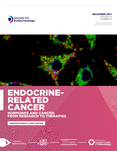Patient-derived tumour xenografts for breast cancer drug discovery
- 1Breast Cancer Functional Genomics, CRUK Cambridge Research Institute, Li Ka Shing Centre, University of Cambridge, Cambridge, UK
- 2Department of Oncology, University of Cambridge, Cambridge, UK
- Correspondence should be addressed to J W Cassidy or A Bruna; Email: john.cassidy{at}cruk.cam.ac.uk or alejandra.bruna{at}cruk.cam.ac.uk
-
Figure 1
High-throughput drug screen using patient-derived material. Figure 1 highlights high-throughput screening approaches using patient tumour material. (1) represents in vitro culture of tumour explants (for example as organoids/tumoroids). (2) represents the integrated PDTX:PDTC platform developed by our lab. In this strategy, patient tumour material is passaged and maintained in the murine host, and patient-derived tumour cells (PDTCs) are periodically dissociated for short-term ex vivo culture and high-throughput drug screens.
-
Figure 2
Biomarker discovery using PDTX models. Figure 2 highlights an unbiased approach for biomarker discovery. (1) a mixed cohort of PDTX models is screened with multiple compounds affecting different members of the same signalling pathway and are subsequently clustered based on responders and non-responders. Genomic correlates of drug response are computed before validation in vivo (2).
- © 2016 The authors












